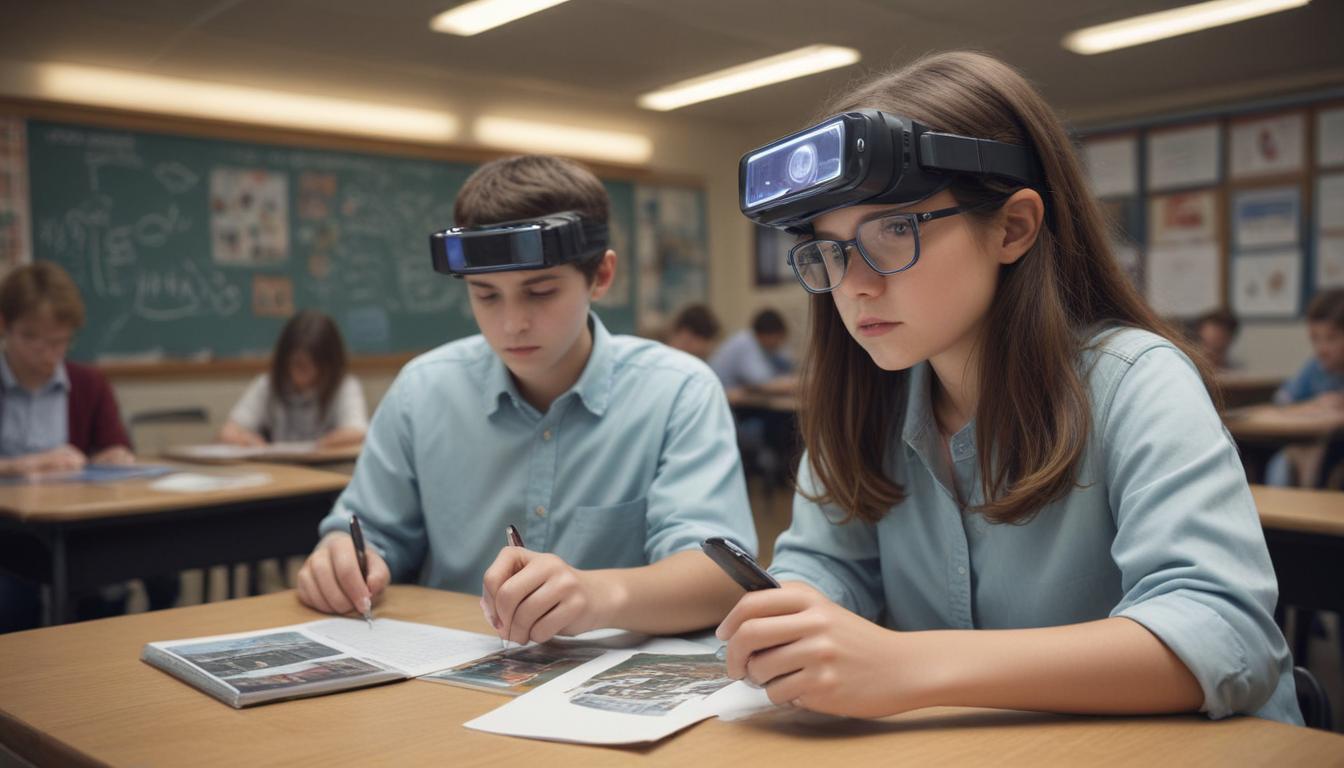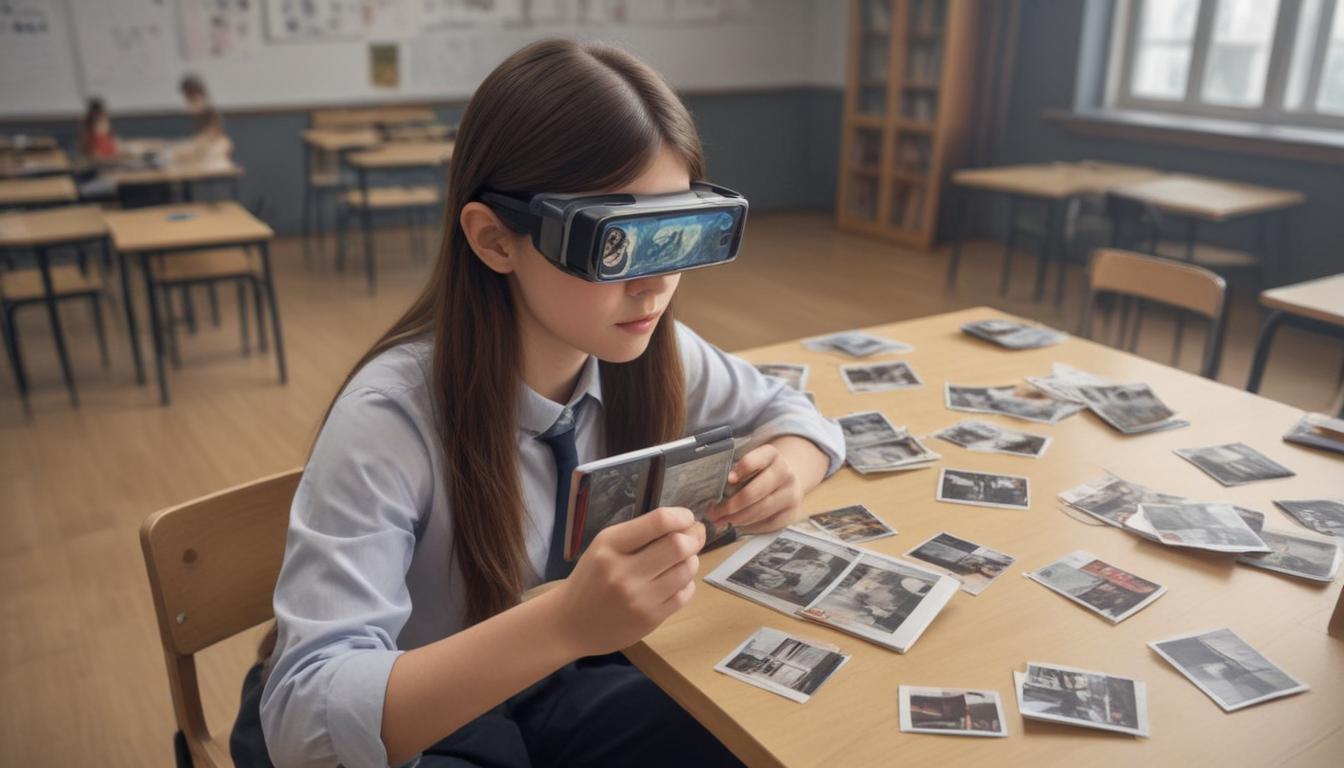Now Reading: Augmented Reality The Future of Learning
- 01
Augmented Reality The Future of Learning
Augmented Reality The Future of Learning

The Future of Augmented Reality in Education
Are you an educator struggling to keep students engaged with traditional teaching methods? Do you find it challenging to explain complex, abstract concepts using only textbooks and 2D diagrams? It’s a common frustration to see students lose focus when faced with subjects that feel distant and intangible. The gap between theoretical knowledge and real-world application can seem vast, leaving both teachers and learners searching for a more effective way to connect the dots. Imagine a tool that could bring your lessons to life, transforming your classroom into an interactive world of discovery where students don’t just read about history, but walk through it.
That tool is here, and it’s called Augmented Reality (AR). AR technology isn’t just a futuristic gimmick; it’s a powerful pedagogical solution that is actively reshaping the educational landscape. By overlaying digital information—like 3D models, videos, and interactive labels—onto the real world through a smartphone or tablet, AR creates immersive and unforgettable learning experiences. It bridges the gap between the abstract and the tangible, turning passive students into active participants in their own education. The future of learning is interactive, and AR is leading the charge.
Moving Beyond the Textbook How AR Transforms Learning
For centuries, the textbook has been the cornerstone of education. While valuable, it is a static, one-dimensional medium. Augmented Reality shatters these limitations by adding dynamic layers of content directly onto the pages of a book or a student’s desk. Think of a biology class studying the human heart. Instead of looking at a flat illustration, students can point their device at a trigger image and see a beating, 3D heart appear before them. They can rotate it, zoom in to see the chambers and valves, and watch the flow of blood in real time. This is the fundamental power of AR in education, it transforms passive consumption of information into active exploration.
This shift creates a more inclusive and effective learning environment that caters to different learning styles. Visual learners thrive on the rich, 3D graphics, while kinesthetic learners benefit from the ability to interact with and manipulate virtual objects. This isn’t about replacing teachers or abandoning traditional methods entirely. Instead, AR serves as a powerful supplement, a tool that empowers educators to demonstrate complex ideas in a way that was previously impossible. It provides a “wow” factor that grabs students’ attention and a functional depth that holds it, fostering genuine curiosity and a deeper passion for learning.
The Tangible Benefits of AR in the Classroom
The implementation of AR in educational settings offers a wealth of practical benefits that go far beyond simple novelty. These advantages directly impact student comprehension, knowledge retention, and overall access to high-quality learning experiences. By making education more engaging and intuitive, AR helps to level the playing field and provides tools that prepare students for a technologically advanced future. It moves learning from a theoretical exercise to a practical, hands-on adventure.
From making dangerous experiments safe to providing access to expensive equipment, AR solves real-world classroom challenges. It democratizes education by allowing schools with limited budgets to provide experiences that were once reserved for the most well-funded institutions. A student can learn to assemble a car engine, explore the surface of Mars, or dissect a frog, all without any physical risk or prohibitive cost. These tangible benefits are proof that AR is not just a trend, but a foundational technology for the classroom of tomorrow.

Enhanced Engagement and Interaction
One of the greatest challenges in any classroom is maintaining student engagement. Augmented Reality tackles this head-on by gamifying the learning process. When a lesson becomes an interactive quest, students are intrinsically motivated to participate. Instead of just reading about ancient Egypt, they can use AR to explore the tombs of the pharaohs, examine artifacts as if they were in a museum, and solve puzzles based on hieroglyphics. This level of interaction turns learning into a captivating experience, significantly boosting focus and participation.
This active involvement is critical for long-term knowledge retention. The human brain is wired to remember experiences far better than it remembers passively read facts. When a student physically manipulates a 3D model of a DNA strand to understand its double helix structure or walks around a virtual model of the solar system to grasp planetary orbits, they are creating strong, multi-sensory memories. This hands-on approach ensures that the information is not just memorized for a test, but truly understood and integrated.
Making Abstract Concepts Concrete
Many of the most important concepts in STEM fields are invisible or highly abstract, making them difficult for students to visualize. Chemistry students struggle to picture molecular bonds, physics students find it hard to conceptualize electromagnetic fields, and math students can have trouble with three-dimensional geometry. AR technology makes these invisible worlds visible. It provides a bridge from the abstract formula on a page to a concrete, interactive model that students can see and manipulate.
For instance, an AR application can render complex chemical compounds in 3D, allowing students to see how different atoms bond and interact. In a geometry lesson, students can place virtual 3D shapes on their desks, walking around them to understand concepts like surface area and volume from every angle. This ability to make the abstract tangible is transformative. It leads to “aha” moments where complex ideas finally click, fostering a deeper and more intuitive understanding that builds a solid foundation for future learning.
Safe and Accessible Practical Training
In fields like medicine, engineering, and vocational trades, hands-on practice is essential. However, real-world training can be expensive, dangerous, and require resources that not all institutions have. AR provides a perfect solution by creating realistic, safe, and repeatable training simulations. A medical student can practice complex surgical procedures on a virtual patient, learning the steps and refining their motor skills without any risk to a living person. Likewise, an aspiring mechanic can learn to disassemble and repair a complex engine in a virtual environment.
Furthermore, this technology dramatically increases accessibility. A school district may not be able to afford a full chemistry lab for every school, but with AR, every student with a basic tablet can conduct virtual experiments, mixing chemicals and observing reactions in a completely safe digital space. This democratization of practical education ensures that students from all backgrounds can gain the hands-on skills and experience they need to succeed in their chosen fields, breaking down economic and logistical barriers to quality training.
What Does the Future Hold for AR in Education
The journey of Augmented Reality in education is only just beginning. As the technology evolves, it will become even more seamless and integrated into our daily lives. The reliance on smartphones and tablets will likely give way to sophisticated, lightweight AR glasses. Imagine a history class where students can see historical figures appear in the room and share their stories, or a botany class where a walk through the schoolyard reveals the name, species, and life cycle of every plant they look at.
The true revolution will come from the integration of AR with other emerging technologies, particularly Artificial Intelligence (AI). An AI-powered AR tutor could provide real-time, personalized feedback as a student works through a problem. If a student is struggling to assemble a virtual circuit, the AI could highlight the correct component and offer verbal guidance tailored to their specific mistake. This combination will create a deeply personalized and adaptive learning ecosystem that caters to each student’s unique pace and style, heralding a new era of truly individualized education.
Embracing the AR Revolution in Learning
Augmented Reality is far more than a futuristic novelty; it is a profound educational tool with the power to redefine how we teach and learn. By transforming passive lessons into interactive adventures, making abstract concepts tangible, and providing safe, accessible training, AR addresses some of the most persistent challenges in education. It sparks curiosity, deepens understanding, and equips students with the skills needed to thrive in an increasingly digital world.
The time to embrace this technology is now. For educators, administrators, and parents, exploring the potential of AR is an investment in a more engaging and effective future for our students. AR will not replace great teachers; it will empower them. By adopting these innovative tools, we can unlock a new dimension of learning, one where every classroom becomes a gateway to discovery and every student has the opportunity to see, touch, and experience their education in a whole new way.





































